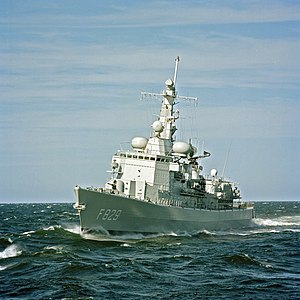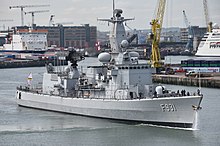Belgian frigate Louise-Marie
 HNLMS Willem van der Zaan (F829) in 1995
| |
| History | |
|---|---|
| Name | Willem van der Zaan |
| Namesake | Schout-bij-nacht Willem van der Zaan |
| Builder | Koninklijke Schelde Groep, Flushing (Netherlands) |
| Laid down | 6 November 1985 |
| Launched | 21 January 1989 |
| Commissioned | 28 November 1991 |
| Decommissioned | 25 August 2006 |
| Fate | Sold to Belgium on 22 December 2005 |
| Name | Louise-Marie |
| Namesake | Queen Louise-Marie of Belgium |
| Christened | 8 April 2008 |
| Acquired | 22 December 2005 |
| Commissioned | 8 April 2008 |
| Homeport | Zeebrugge Naval Base |
| Identification |
|
| Status | Active |
| General characteristics | |
| Class and type | Karel Doorman-class frigate |
| Displacement | 2,800 tonnes |
| Length | 122.325 m (401.33 ft) |
| Beam | 14.37 m (47.1 ft) |
| Draught | 6.2 m (20 ft) |
| Speed | 30 knots (56 km/h; 35 mph) |
| Complement | 15 officers, 70 NCO's, 60 sailors |
| Armament |
|
| Aircraft carried | 1 x NH-90 NFH helicopter |
Louise-Marie (F931) is a Karel Doorman-class frigate of the Marine Component of the Belgian Armed Forces that was commissioned in 2008. It is the second of the two frigates of this class that were purchased from the Royal Netherlands Navy on 22 December 2005. It was originally commissioned in 1991 in the Netherlands, where it served as HNLMS Willem van der Zaan (F829).
Service

HNLMS Willem van der Zaan was rechristened Louise-Marie (F931) on 8 April 2008 in Antwerp by Queen Paola of Belgium.[1] It was named after Louise-Marie, a naval vessel purchased by the Belgian navy in 1840, which in turn was named after Queen Louise-Marie of Belgium, the wife of Leopold I.
Missions
In September 2010, Louise-Marie was reported to be preparing for a second deployment to the Horn of Africa.[2]
On 29 November 2013, the ship arrived in London, UK as part of the preparations for the centenary of the start of World War I delivering soil from 70 World War I battlefields collected by British and Belgian schoolchildren for the Flanders Fields Memorial Garden in London's Wellington Barracks.[3]
On January 19, 2024, it was announced the Louise-Marie was being sent to the Red Sea to aid in the EU-led Operation Aspides to protect naval shipping in response to a rise in Houthi attacks on commercial vessels near the coast of Yemen. [4] Scheduled to transit the Suez Canal on April 12, deployment indefinitely postponed due to failed operational and technical tests while transiting the Mediterranean Sea, including an incident where a RIM-7 Sea Sparrow missile was reportedly "stuck" in its launch tube.[5][6] On 27 April, the issues were resolved and Louise-Marie set course for the area of operations.[7]
See also
- Belgian frigate Leopold I (F930), for the other ship of this class that was sold to Belgium.
References
- ^ "Nederlands fregat voortaan onder Belgische vlag" (in Dutch). De Telegraaf. 2 April 2008. Archived from the original on 5 April 2008. Retrieved 6 August 2015.
- ^ "defence.professionals". Archived from the original on March 17, 2012. Retrieved 2010-09-29.
- ^ "WW1 'sacred soil' ceremony takes place in London". BBC News. 30 November 2013. Retrieved 6 August 2015.
- ^ "Belgium sends warship to Red Sea". Politico. 19 January 2024. Retrieved 20 January 2024.
- ^ Ruitenberg, Rudy. "Belgium postpones Red Sea deployment after frigate mishaps". DefenseNews. Paris. Retrieved 26 April 2024.
{{cite web}}: CS1 maint: url-status (link) - ^ Goossens, Kasper (13 April 2024). "Raket blijft steken; inzet Belgisch fregat Rode Zee uitgesteld". Marineschepen.nl (in Dutch). Archived from the original on 26 April 2024. Retrieved 26 April 2024.
- ^ Karreman, Jaime (29 April 2024). "Na lanceerproblemen is Belgisch fregat nu klaar voor Rode Zee". Marineschepen.nl (in Dutch). Archived from the original on 29 April 2024. Retrieved 29 April 2024.
External links
- Homepage of HNLMS Willem van der Zaan on the website of the Royal Netherlands Navy - Only available in Dutch.
- CS1 Dutch-language sources (nl)
- CS1 maint: url-status
- Articles with short description
- Short description is different from Wikidata
- MMSI Number
- 1989 ships
- Ships built in Vlissingen
- Karel Doorman-class frigates of the Belgian Navy
- Karel Doorman-class frigates
- Naval ships of Belgium
- All stub articles
- European military stubs
- Belgium stubs
- European naval ship stubs